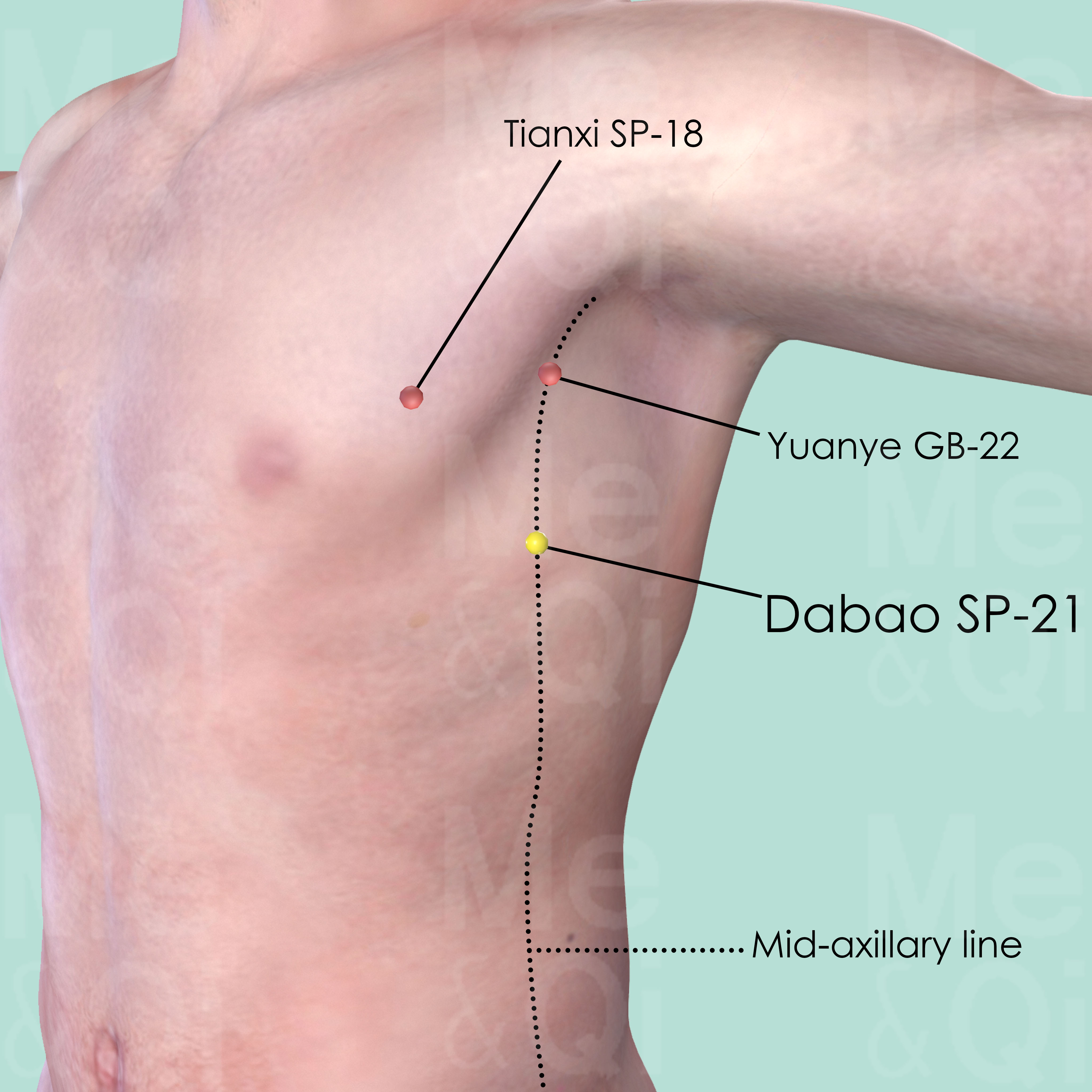Body Painaccording to TCM
Symptom family: General Body Pain and Discomfort
Root Causes of Body Pain in TCM
Explore below more details about what might cause Body pain according to TCM.
- By Syndrome
- By Organ
- Cold
- Wind
- Heat
- Dampness
- Phlegm
- Yang Deficiency
- Summer Heat
- View More Causes
- Lung
Cold
In TCM "Cold" as a pattern of disharmony refers to a specific type of imbalance within the body's systems, often linked to a deficiency or weakness. It's not about feeling physically cold or having a common cold, but rather a metaphorical description of certain symptoms and underlying conditions. When a TCM practitioner says someone suffers from "Cold," it usually implies that the body's Yang energy, which is warm and active, is insufficient or overpowered by Yin energy, which is cool and passive. Symptoms of Cold in TCM can include a general feeling of coldness, cold limbs, pale complexion, low energy, slow metabolism, and a preference for warmth. ... see more
Cold Patterns That Can Lead to Body Pain
Common Symptoms: Aversion To Cold Fever Chills Lack Of Sweating Headaches Absence Of Thirst Sneezing Nasal Discharge
| Pattern Name | Relevant Symptoms | Relevant Formulas |
|---|---|---|
| Wind-Cold | Body aches, Aversion to cold, Fever, Sneezing, Coughing, Nasal discharge, Occipital headache, Occipital stiffness, Congested nose, White and watery sputum... see more | Jiu Wei Qiang Huo Tang | Ma Huang Tang | Jing Fang Bai Du San | Cong Chi Tang | Huo Ren Cong Shi Tang | Jia Wei Xiang Su San | Shi Shen Tang | Jin Fei Cao San | Wu Ji San |
| Wind-Cold invading the Lungs | Body aches, Aversion to cold, Fever, Itchy throat, Shortness of breath, Congested nose, Nasal discharge, Sneezing, Headaches, Body pain, White and watery sputum, Coughing and wheezing with copious sputum... see more | Ma Huang Tang | Ge Gen Tang | Xin Yi San | Zhi Sou San |
| Exterior-Cold | Generalized body pain, Aversion to cold, Fever, Body pain, Stiff neck, Lack of sweating, Absence of thirst, Feeling hot, Chills... see more | Gui Zhi Tang | Ma Huang Tang |
| Early Stage Summerheat with Exterior Wind-Cold | aching body, Fever, Chills, Lack of sweating, Headaches, Thirst, Flushed face, Stifling sensation in the chest, Feeling of heaviness, Body pain, Dark urine, Urinary dysfunction... see more | Xin Jia Xiang Ru Yin |
| Exterior Cold invading with Interior Heat from Stagnation | Generalized body pain, Fever without perspiration, Body pain, Thirst, Irritability, Upper respiratory tract infections, Influenza, Purulent keratitis, Viral conjunctivitis, Sinusitis, Bronchial asthma... see more | Da Qing Long Tang |
| Yang Deficiency with Cold-Damp | Generalized body pain, Body pain, Bone and joint pain, Cold extremities, Absence of thirst, Aversion to cold, Migraine, Cluster headache, Trigeminal neuralgia, Piriformis syndrome, Rheumatoid arthritis... see more | Fu Zi Tang |
Wind
In TCM "Wind" is a concept that represents a pattern of disharmony, often characterized by its sudden and unpredictable nature, much like a gusty wind changing direction without warning. This pattern is associated with symptoms that come and go quickly or move around the body, such as itching, tremors, or even certain types of pain. Wind is considered to be a primary cause of illnesses that have these rapidly changing characteristics. In TCM, external Wind often refers to illnesses that start suddenly, like the common cold, believed to be caused by external pathogenic factors like climatic changes. On the other hand, internal Wind can be linked to internal imbalances and can manifest in conditions like dizziness or spasms. ... see more
Wind Patterns That Can Lead to Body Pain
Common Symptoms: Fever Aversion To Cold Headaches Sneezing Nasal Discharge Congested Nose Chills Lack Of Sweating
| Pattern Name | Relevant Symptoms | Relevant Formulas |
|---|---|---|
| Damp-Wind | Body aches, Aversion to cold, Fever, Neck gland swelling, Nausea, Perspiration, Occipital stiffness, Body pain, Muscle pain, Feeling of heaviness, Swollen joints... see more | Qiang Huo Sheng Shi Tang | Jiu Wei Qiang Huo Tang | Cang Er Zi San | Xiao Feng San | Ku Shen Tang | Hai Tong Pi Tang |
| Wind-Cold | Body aches, Aversion to cold, Fever, Sneezing, Coughing, Nasal discharge, Occipital headache, Occipital stiffness, Congested nose, White and watery sputum... see more | Jiu Wei Qiang Huo Tang | Ma Huang Tang | Jing Fang Bai Du San | Cong Chi Tang | Huo Ren Cong Shi Tang | Jia Wei Xiang Su San | Shi Shen Tang | Jin Fei Cao San | Wu Ji San |
| Wind-Cold invading the Lungs | Body aches, Aversion to cold, Fever, Itchy throat, Shortness of breath, Congested nose, Nasal discharge, Sneezing, Headaches, Body pain, White and watery sputum, Coughing and wheezing with copious sputum... see more | Ma Huang Tang | Ge Gen Tang | Xin Yi San | Zhi Sou San |
| Wind-Heat invading the Lungs | Body aches, Aversion to cold, Fever, Coughing, Sore throat, Congested nose, Nasal discharge, Copious thick yellow sputum, Sneezing, Headaches, Body pain, Thirst, Tonsil swelling... see more | Yin Qiao San |
| Early Stage Summerheat with Exterior Wind-Cold | aching body, Fever, Chills, Lack of sweating, Headaches, Thirst, Flushed face, Stifling sensation in the chest, Feeling of heaviness, Body pain, Dark urine, Urinary dysfunction... see more | Xin Jia Xiang Ru Yin |
Heat
In TCM "Heat" signifies an excess of Yang energy, leading to an imbalance where heat predominates over the body's cool Yin aspects. This condition is metaphorically akin to an internal over-heating. Symptoms indicative of Heat can include feelings of warmth, fever, sweating, irritability, red face, thirst with a preference for cold drinks, and a rapid pulse. The tongue may appear red with a yellow coating. Unlike the common interpretation of heat in terms of temperature, in TCM, it represents a state of hyperactivity or inflammation in the body.... see more
Heat Patterns That Can Lead to Body Pain
Common Symptoms: Thirst Fever Headaches Aversion To Cold Dark Urine Perspiration Stiff Neck Coughing
| Pattern Name | Relevant Symptoms | Relevant Formulas |
|---|---|---|
| Exterior-Heat | Body aches, Aversion to cold, Fever, Perspiration, Thirst, Body pain, Stiff neck | Yin Qiao San | Shi Gao Tang |
| Wind-Heat invading the Lungs | Body aches, Aversion to cold, Fever, Coughing, Sore throat, Congested nose, Nasal discharge, Copious thick yellow sputum, Sneezing, Headaches, Body pain, Thirst, Tonsil swelling... see more | Yin Qiao San |
| Early Stage Summerheat with Exterior Wind-Cold | aching body, Fever, Chills, Lack of sweating, Headaches, Thirst, Flushed face, Stifling sensation in the chest, Feeling of heaviness, Body pain, Dark urine, Urinary dysfunction... see more | Xin Jia Xiang Ru Yin |
| Exterior Cold invading with Interior Heat from Stagnation | Generalized body pain, Fever without perspiration, Body pain, Thirst, Irritability, Upper respiratory tract infections, Influenza, Purulent keratitis, Viral conjunctivitis, Sinusitis, Bronchial asthma... see more | Da Qing Long Tang |
Dampness
"Dampness" in TCM is a concept that describes a pattern of disharmony where the body accumulates excess moisture. Imagine the heavy, sticky feeling you get on a very humid day; that's similar to what dampness feels like internally. It can manifest as a sense of heaviness, bloating, sluggishness, or even a foggy mind. This condition is often thought to arise from environmental factors like living in a damp place, dietary habits that promote moisture in the body, or internal imbalances that hinder the body's ability to process fluids properly. In TCM, dampness can obstruct the normal flow of energy and fluids in the body, leading to various symptoms.... see more
Dampness Patterns That Can Lead to Body Pain
Common Symptoms: Aversion To Cold Fever Feeling Of Heaviness Neck Gland Swelling Nausea Perspiration Occipital Stiffness Muscle Pain
| Pattern Name | Relevant Symptoms | Relevant Formulas |
|---|---|---|
| Damp-Wind | Body aches, Aversion to cold, Fever, Neck gland swelling, Nausea, Perspiration, Occipital stiffness, Body pain, Muscle pain, Feeling of heaviness, Swollen joints... see more | Qiang Huo Sheng Shi Tang | Jiu Wei Qiang Huo Tang | Cang Er Zi San | Xiao Feng San | Ku Shen Tang | Hai Tong Pi Tang |
| Early Stage Summerheat with Exterior Wind-Cold | aching body, Fever, Chills, Lack of sweating, Headaches, Thirst, Flushed face, Stifling sensation in the chest, Feeling of heaviness, Body pain, Dark urine, Urinary dysfunction... see more | Xin Jia Xiang Ru Yin |
| Yang Deficiency with Cold-Damp | Generalized body pain, Body pain, Bone and joint pain, Cold extremities, Absence of thirst, Aversion to cold, Migraine, Cluster headache, Trigeminal neuralgia, Piriformis syndrome, Rheumatoid arthritis... see more | Fu Zi Tang |
Phlegm
In TCM "Phlegm" as a pattern of disharmony is a complex concept that extends beyond the physical manifestation of mucus. It represents a pathological factor that can disrupt the flow of Qi (vital energy) and blood, leading to various health issues. Phlegm in TCM is seen as a sticky, turbid substance arising from the body's inability to metabolize fluids properly, often due to a dysfunction of the spleen. It's not only associated with respiratory problems like cough and congestion but also with systemic issues. Symptoms can include a feeling of heaviness, mental cloudiness, dizziness, and in some cases, the formation of lumps or masses. Phlegm can even be "invisible," contributing to emotional disturbances like depression or stress. ... see more
Phlegm Patterns That Can Lead to Body Pain
Common Symptoms: Feeling Of Heaviness Muscle Pain Lack Of Sweating Absence Of Thirst Profuse White Sputum Alternating Fever And Chills Upper Respiratory Tract Infections Viral Conjunctivitis
| Pattern Name | Relevant Symptoms | Relevant Formulas |
|---|---|---|
| Phlegm-Fluids in the limbs | Generalized body pain, Feeling of heaviness, Muscle pain, Lack of sweating, Absence of thirst, Profuse white sputum, Swollen limbs, Urinary dysfunction... see more | Da Qing Long Tang |
| Phlegm-Fluids above the diaphragm | Generalized body pain, Coughing, Asthma, Edema, Feeling of oppression of the chest, Dizziness, Profuse white sputum... see more | Xiao Qing Long Tang |
Yang Deficiency
Yang deficiency in TCM refers to a state where the body's Yang energy, which is responsible for warmth, activity, and function, is weakened or diminished. This pattern of disharmony often arises from chronic illness, aging, or inherent constitutional weakness. Symptoms of Yang deficiency are typically associated with cold and sluggishness, such as a feeling of coldness, cold extremities, pale complexion, low energy or fatigue, and a desire for warmth. Digestive issues like poor appetite, loose stools, and water retention can also be indicative of Yang deficiency.... see more
Yang Deficiency Patterns That Can Lead to Body Pain
| Pattern Name | Relevant Symptoms | Relevant Formulas |
|---|---|---|
| Yang Deficiency with Cold-Damp | Generalized body pain, Body pain, Bone and joint pain, Cold extremities, Absence of thirst, Aversion to cold, Migraine, Cluster headache, Trigeminal neuralgia, Piriformis syndrome, Rheumatoid arthritis... see more | Fu Zi Tang |
Summer Heat
"Summer-Heat" in TCM is a unique concept that refers to a pattern of disharmony often associated with the hot summer months. Imagine the intense heat of summer stressing your body, like being in a sweltering, humid environment for too long. This can lead to symptoms like feeling overheated, excessive sweating, a feeling of irritation, and sometimes even nausea or dizziness. In TCM, this condition is thought to arise from the external environment's heat affecting the body's internal balance. It's similar to how we might feel uncomfortable and out of sorts on a very hot day. ... see more
Summer Heat Patterns That Can Lead to Body Pain
| Pattern Name | Relevant Symptoms | Relevant Formulas |
|---|---|---|
| Early Stage Summerheat with Exterior Wind-Cold | aching body, Fever, Chills, Lack of sweating, Headaches, Thirst, Flushed face, Stifling sensation in the chest, Feeling of heaviness, Body pain, Dark urine, Urinary dysfunction... see more | Xin Jia Xiang Ru Yin |
Lung
In TCM the Lungs are seen as the organ responsible for controlling Qi and respiration, as well as being a key part of the body's defensive system. They are thought to maintain the balance and flow of air and moisture, and are closely linked to the skin and hair. When the Lungs are imbalanced or malfunctioning in TCM, it can lead to respiratory issues like coughing or asthma, a weakened immune system, dry skin, and emotional disturbances such as sadness or grief. These symptoms are believed to arise from disruptions in the Lungs' ability to regulate Qi and protect the body, highlighting their central role in maintaining overall health and well-being.... see more
Lung Patterns That Can Lead to Body Pain
Common Symptoms: Aversion To Cold Fever Congested Nose Nasal Discharge Sneezing Headaches Itchy Throat Shortness Of Breath
| Pattern Name | Relevant Symptoms | Relevant Formulas |
|---|---|---|
| Wind-Cold invading the Lungs | Body aches, Aversion to cold, Fever, Itchy throat, Shortness of breath, Congested nose, Nasal discharge, Sneezing, Headaches, Body pain, White and watery sputum, Coughing and wheezing with copious sputum... see more | Ma Huang Tang | Ge Gen Tang | Xin Yi San | Zhi Sou San |
| Wind-Heat invading the Lungs | Body aches, Aversion to cold, Fever, Coughing, Sore throat, Congested nose, Nasal discharge, Copious thick yellow sputum, Sneezing, Headaches, Body pain, Thirst, Tonsil swelling... see more | Yin Qiao San |
TCM Herbal Formulas for Body Pain
Explore below some TCM herbal formulas used to address body pain, organized by cause and by formula type.
- By Cause
- By Formula Type
- Cold
- Wind
- Heat
- Dampness
- Phlegm
- Yang Deficiency
- Summer Heat
- View More Causes
- Formulas that clear wind-Cold
- External formulas for external disorders
- Formulas that dredge and disperse external wind
- Formulas that clear early-stage exterior disorders
- Formulas that dispel wind-Damp
- Formulas that release the exterior and clear the interior
- Formulas that release the exterior and warm the interior
- Formulas that transform phlegm and extinguish wind
- Formulas that warm and transform water and dampness
- Formulas that dispel summer-Heat and resolve exterior
Top Formula for Cold:
Ma Huang Tang
Suitable for Cold patterns that may cause body pain, such as Wind-Cold or Wind-Cold invading the Lungs
Learn moreAll Formulas Recommended for Body Pain Caused by Cold
| Formula | Patterns Suitable For |
|---|---|
| Ma Huang Tang | Wind-Cold, Wind-Cold invading the Lungs, Exterior-Cold |
| Jiu Wei Qiang Huo Tang | Wind-Cold |
| Da Qing Long Tang | Exterior Cold invading with Interior Heat from Stagnation |
| Gui Zhi Tang | Exterior-Cold |
| Jing Fang Bai Du San | Wind-Cold |
| Cong Chi Tang | Wind-Cold |
| Huo Ren Cong Shi Tang | Wind-Cold |
| Jia Wei Xiang Su San | Wind-Cold |
| Shi Shen Tang | Wind-Cold |
| Jin Fei Cao San | Wind-Cold |
| Wu Ji San | Wind-Cold |
| Ge Gen Tang | Wind-Cold invading the Lungs |
| Xin Yi San | Wind-Cold invading the Lungs |
| Zhi Sou San | Wind-Cold invading the Lungs |
| Fu Zi Tang | Yang Deficiency with Cold-Damp |
| Xin Jia Xiang Ru Yin | Early Stage Summerheat with Exterior Wind-Cold |
Top Formula for Wind:
Ma Huang Tang
Suitable for Wind patterns that may cause body pain, such as Wind-Cold or Wind-Cold invading the Lungs
Learn moreAll Formulas Recommended for Body Pain Caused by Wind
| Formula | Patterns Suitable For |
|---|---|
| Ma Huang Tang | Wind-Cold, Wind-Cold invading the Lungs |
| Jiu Wei Qiang Huo Tang | Damp-Wind, Wind-Cold |
| Yin Qiao San | Wind-Heat invading the Lungs |
| Qiang Huo Sheng Shi Tang | Damp-Wind |
| Cang Er Zi San | Damp-Wind |
| Xiao Feng San | Damp-Wind |
| Ku Shen Tang | Damp-Wind |
| Hai Tong Pi Tang | Damp-Wind |
| Jing Fang Bai Du San | Wind-Cold |
| Cong Chi Tang | Wind-Cold |
| Huo Ren Cong Shi Tang | Wind-Cold |
| Jia Wei Xiang Su San | Wind-Cold |
| Shi Shen Tang | Wind-Cold |
| Jin Fei Cao San | Wind-Cold |
| Wu Ji San | Wind-Cold |
| Ge Gen Tang | Wind-Cold invading the Lungs |
| Xin Yi San | Wind-Cold invading the Lungs |
| Zhi Sou San | Wind-Cold invading the Lungs |
| Xin Jia Xiang Ru Yin | Early Stage Summerheat with Exterior Wind-Cold |
Top Formula for Heat:
Yin Qiao San
Suitable for Heat patterns that may cause body pain, such as Exterior-Heat or Wind-Heat invading the Lungs
Learn moreAll Formulas Recommended for Body Pain Caused by Heat
| Formula | Patterns Suitable For |
|---|---|
| Yin Qiao San | Exterior-Heat, Wind-Heat invading the Lungs |
| Da Qing Long Tang | Exterior Cold invading with Interior Heat from Stagnation |
| Shi Gao Tang | Exterior-Heat |
| Xin Jia Xiang Ru Yin | Early Stage Summerheat with Exterior Wind-Cold |
Top Formula for Dampness:
Jiu Wei Qiang Huo Tang
Suitable for Dampness patterns that may cause body pain, such as Damp-Wind
Learn moreAll Formulas Recommended for Body Pain Caused by Dampness
| Formula | Patterns Suitable For |
|---|---|
| Jiu Wei Qiang Huo Tang | Damp-Wind |
| Qiang Huo Sheng Shi Tang | Damp-Wind |
| Cang Er Zi San | Damp-Wind |
| Xiao Feng San | Damp-Wind |
| Ku Shen Tang | Damp-Wind |
| Hai Tong Pi Tang | Damp-Wind |
| Fu Zi Tang | Yang Deficiency with Cold-Damp |
| Xin Jia Xiang Ru Yin | Early Stage Summerheat with Exterior Wind-Cold |
Top Formula for Phlegm:
Da Qing Long Tang
Suitable for Phlegm patterns that may cause body pain, such as Phlegm-Fluids in the limbs
Learn moreAll Formulas Recommended for Body Pain Caused by Phlegm
| Formula | Patterns Suitable For |
|---|---|
| Da Qing Long Tang | Phlegm-Fluids in the limbs |
| Xiao Qing Long Tang | Phlegm-Fluids above the diaphragm |
Top Formula for Yang Deficiency:
Fu Zi Tang
Suitable for Yang Deficiency patterns that may cause body pain, such as Yang Deficiency with Cold-Damp
Learn moreTop Formula for Summer Heat:
Xin Jia Xiang Ru Yin
Suitable for Summer Heat patterns that may cause body pain, such as Early Stage Summerheat with Exterior Wind-Cold
Learn moreFormulas that clear Wind-Cold
These formulas are suitable for some body pain-causing patterns like Exterior-Full or Wind-Cold.
One such formula is Ma Huang Tang, with ephedra as a key herb.
Other formulas of this category are listed in the table below.
All "formulas that clear wind-Cold" recommended for body pain
| Formula | Patterns Suitable For (if applicable) |
|---|---|
| Ma Huang Tang | Exterior-Full, Wind-Cold, Wind-Cold invading the Lungs, Exterior-Cold |
| Jiu Wei Qiang Huo Tang | Damp-Wind, Wind-Cold |
| Gui Zhi Tang | Exterior-Empty, Exterior-Cold |
| Da Qing Long Tang | Exterior Cold invading with Interior Heat from Stagnation, Phlegm-Fluids in the limbs... see more |
| Jia Wei Xiang Su San | Wind-Cold |
| Shi Shen Tang | Wind-Cold |
| Jin Fei Cao San | Wind-Cold |
| Ge Gen Tang | Wind-Cold invading the Lungs |
| Xiao Qing Long Tang | Phlegm-Fluids above the diaphragm |
External formulas for External disorders
These formulas are suitable for some body pain-causing patterns like Exterior-Heat or Wind-Heat invading the Lungs.
One such formula is Yin Qiao San, with honeysuckle flowers as a key herb.
Other formulas of this category are listed in the table below.
All "external formulas for external disorders" recommended for body pain
| Formula | Patterns Suitable For (if applicable) |
|---|---|
| Yin Qiao San | Exterior-Heat, Wind-Heat invading the Lungs |
| Ku Shen Tang | Damp-Wind |
| Hai Tong Pi Tang | Damp-Wind |
| Jing Fang Bai Du San | Wind-Cold |
Formulas that dredge and disperse External Wind
These formulas are suitable for some body pain-causing patterns like Damp-Wind.
One such formula is Cang Er Zi San, with cocklebur fruit as a key herb.
Other formulas of this category are listed in the table below.
All "formulas that dredge and disperse external wind" recommended for body pain
| Formula | Patterns Suitable For (if applicable) |
|---|---|
| Cang Er Zi San | Damp-Wind |
| Xiao Feng San | Damp-Wind |
| Xin Yi San | Wind-Cold invading the Lungs |
Formulas that clear early-stage Exterior disorders
These formulas are suitable for some body pain-causing patterns like Wind-Cold.
One such formula is Cong Chi Tang, with scallions as a key herb.
Other formulas of this category are listed in the table below.
All "formulas that clear early-stage exterior disorders" recommended for body pain
| Formula | Patterns Suitable For (if applicable) |
|---|---|
| Cong Chi Tang | Wind-Cold |
| Huo Ren Cong Shi Tang | Wind-Cold |
Formulas that dispel Wind-Damp
These formulas are suitable for some body pain-causing patterns like Damp-Wind.
One such formula is Qiang Huo Sheng Shi Tang, with notopterygium root as a key herb.
Formulas that Release the Exterior and Clear the Interior
These formulas are suitable for some body pain-causing patterns like Exterior-Heat.
One such formula is Shi Gao Tang, with gypsum as a key herb.
Formulas that transform Phlegm and extinguish Wind
These formulas are suitable for some body pain-causing patterns like Wind-Cold invading the Lungs.
One such formula is Zhi Sou San, with aster root as a key herb.
Formulas that warm and transform water and Dampness
These formulas are suitable for some body pain-causing patterns like Yang Deficiency with Cold-Damp.
One such formula is Fu Zi Tang, with prepared aconite as a key herb.
Formulas that dispel Summer-Heat and resolve Exterior
These formulas are suitable for some body pain-causing patterns like Early Stage Summerheat with Exterior Wind-Cold.
One such formula is Xin Jia Xiang Ru Yin, with vietnamese balm as a key herb.
Acupoints for Body Pain
Explore below some acupoints used to address body pain, organized by meridian.
- By Meridian
- Bladder Channel
- Governing Vessel
- Spleen Channel
- Gall Bladder Channel
- Extra Points: Back (EX-B)
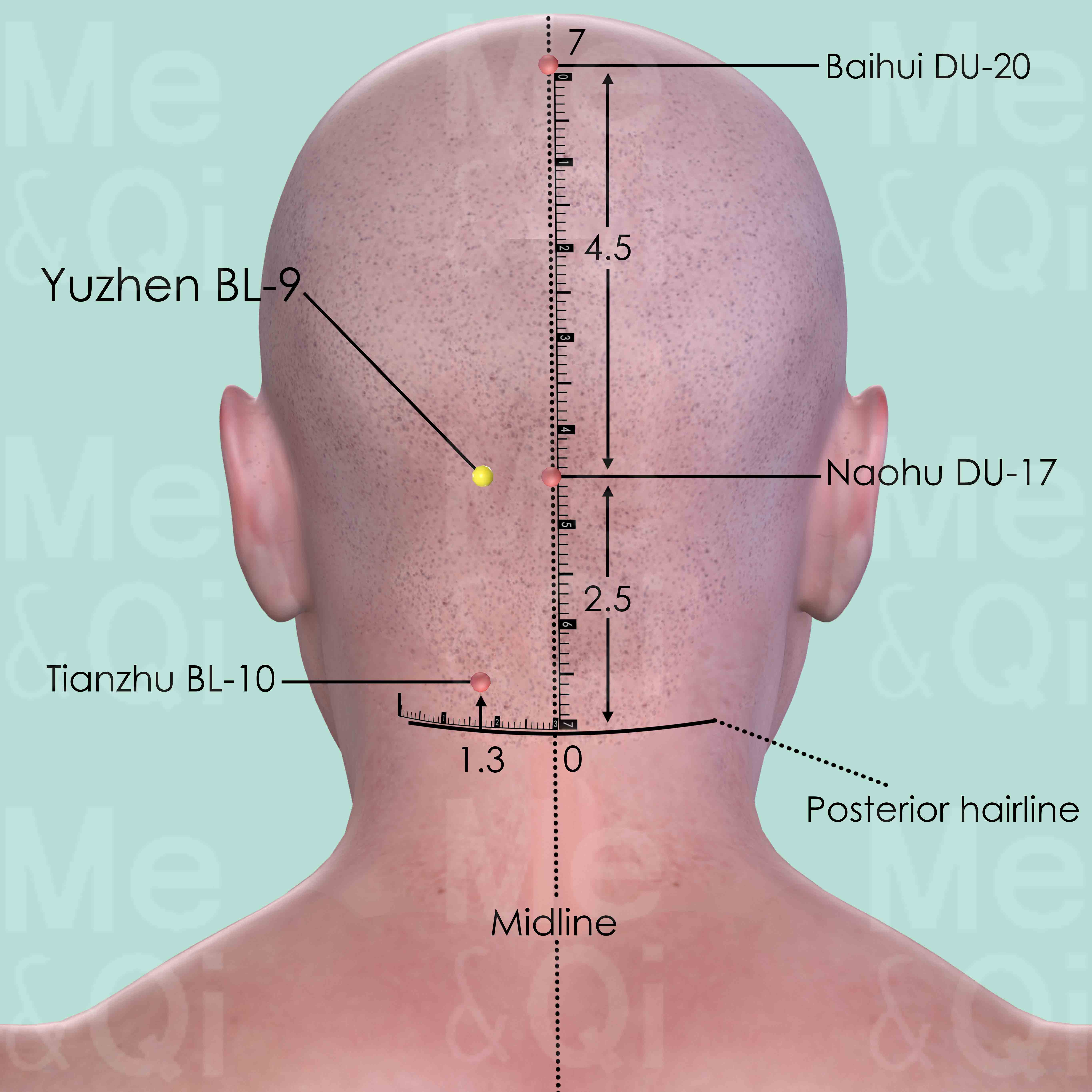
Yuzhen BL-9
First identify Naohu DU-17 which is on the superior border of the external occipital protuberance. Yuzhen BL-9 is 1.3 cun lateral to Naohu DU-17.
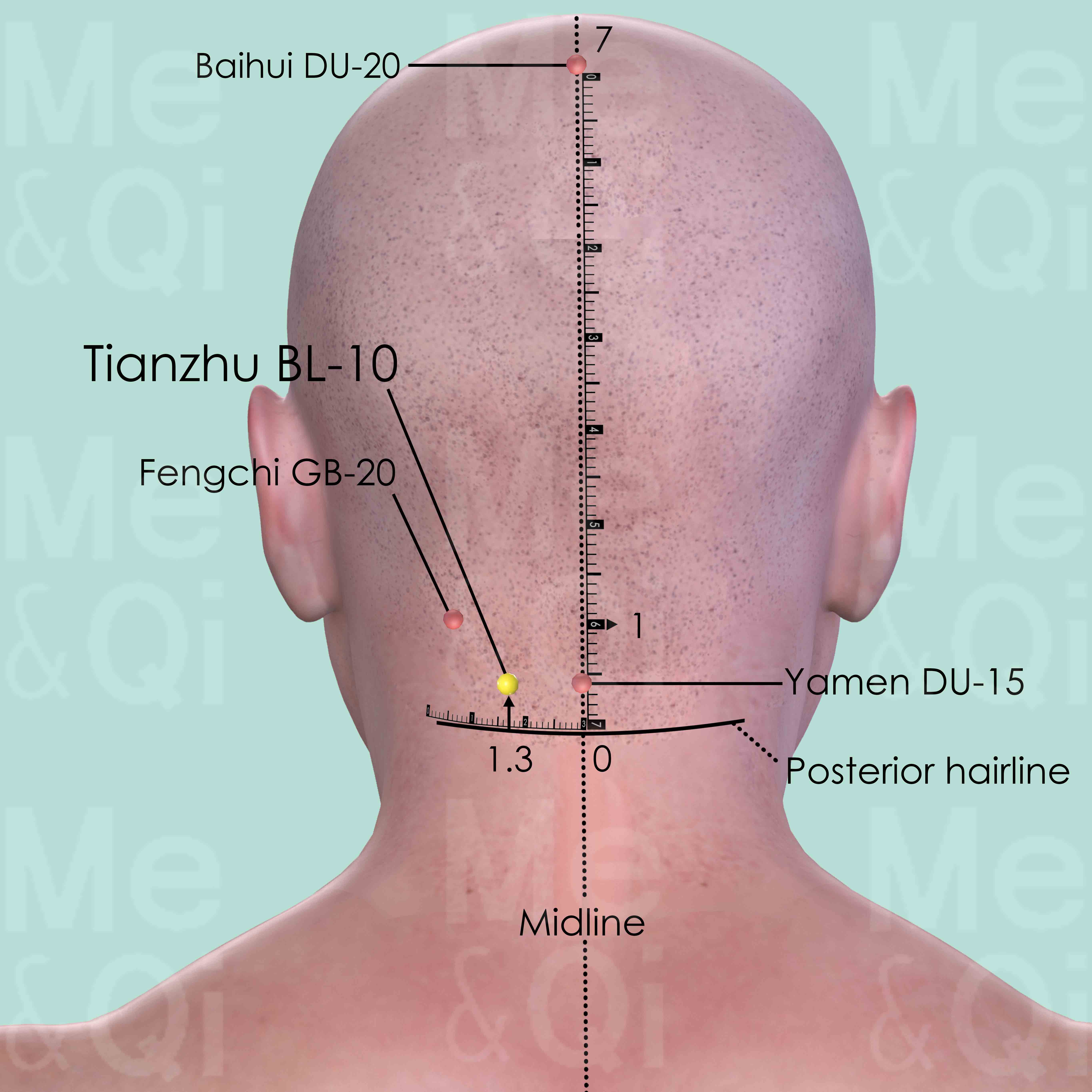
Tianzhu BL-10
1.3 cun lateral to Yamen DU-15 on the posterior midline, 0.5 cun above the posterior hairline, on the lateral side of trapezius muscle.
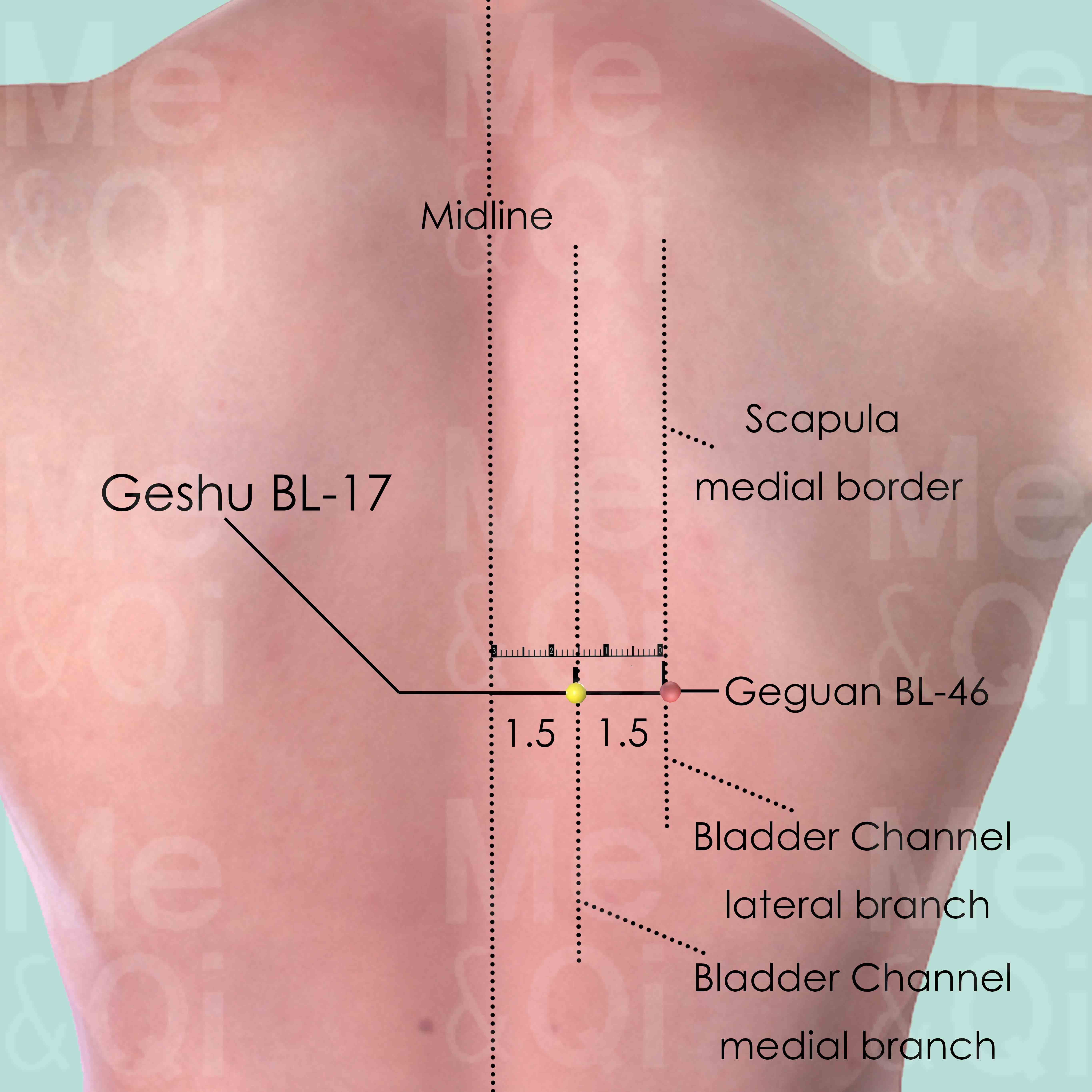
Geshu BL-17
1.5 cun lateral to the lower border of the spinous process of the 7th thoracic vertebra (T7).
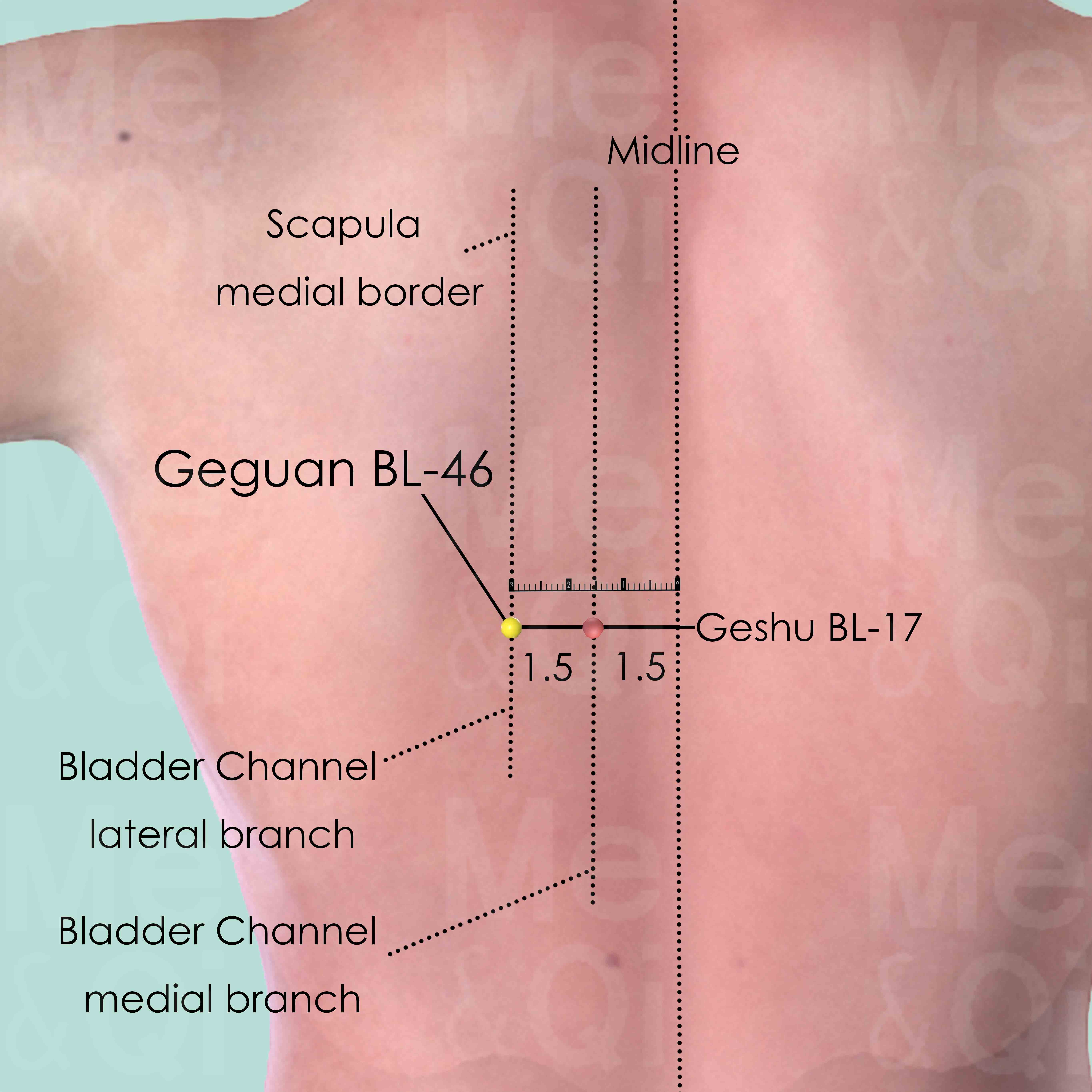
Geguan BL-46
3 cun (about 4 finger-breadths) lateral to the lower border of the spinous process of the 7th thoracic vertebra (T7).
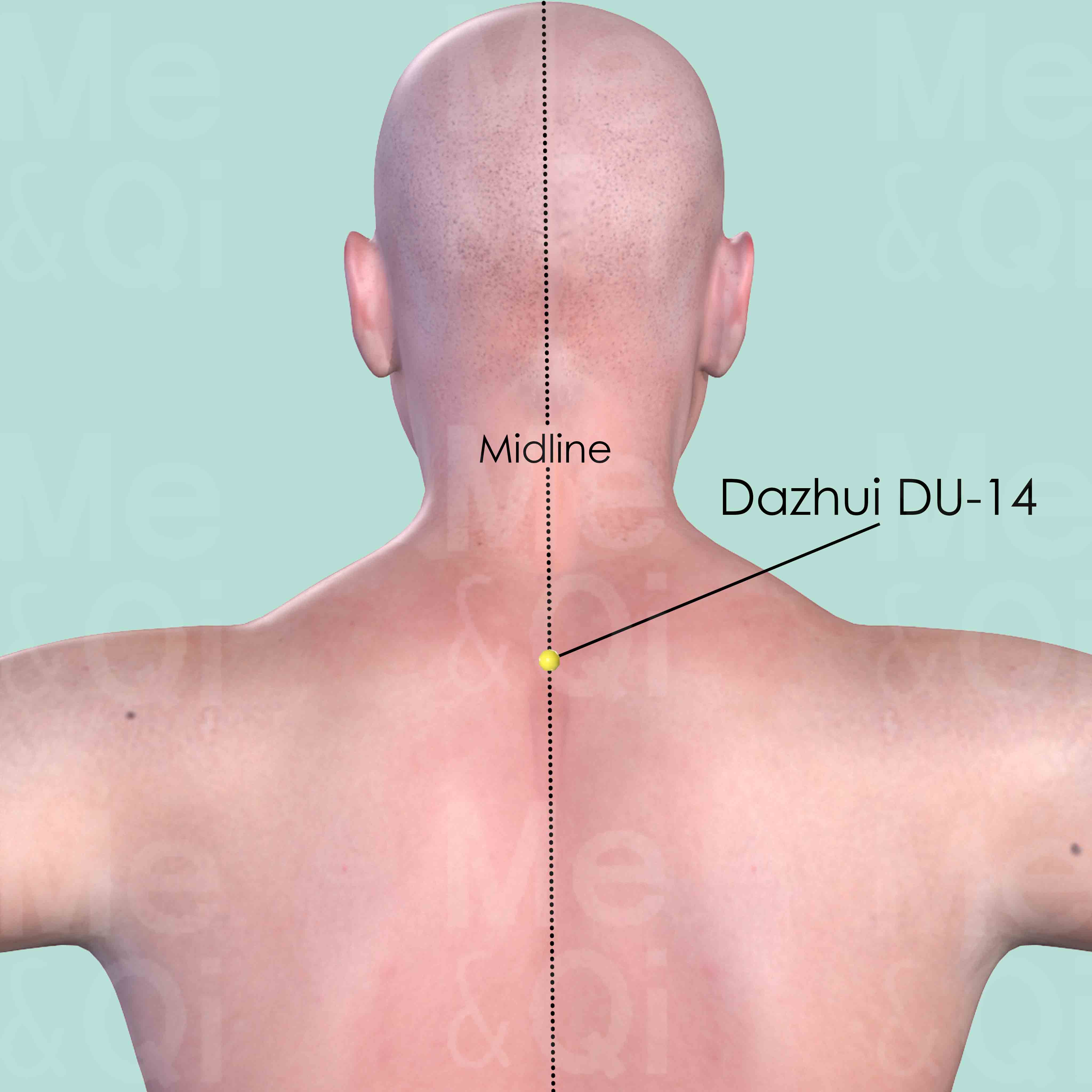
Dazhui DU-14
On the midline at the base of the neck, in the depression below the spinous process of the seventh cervical vertebra (C7).
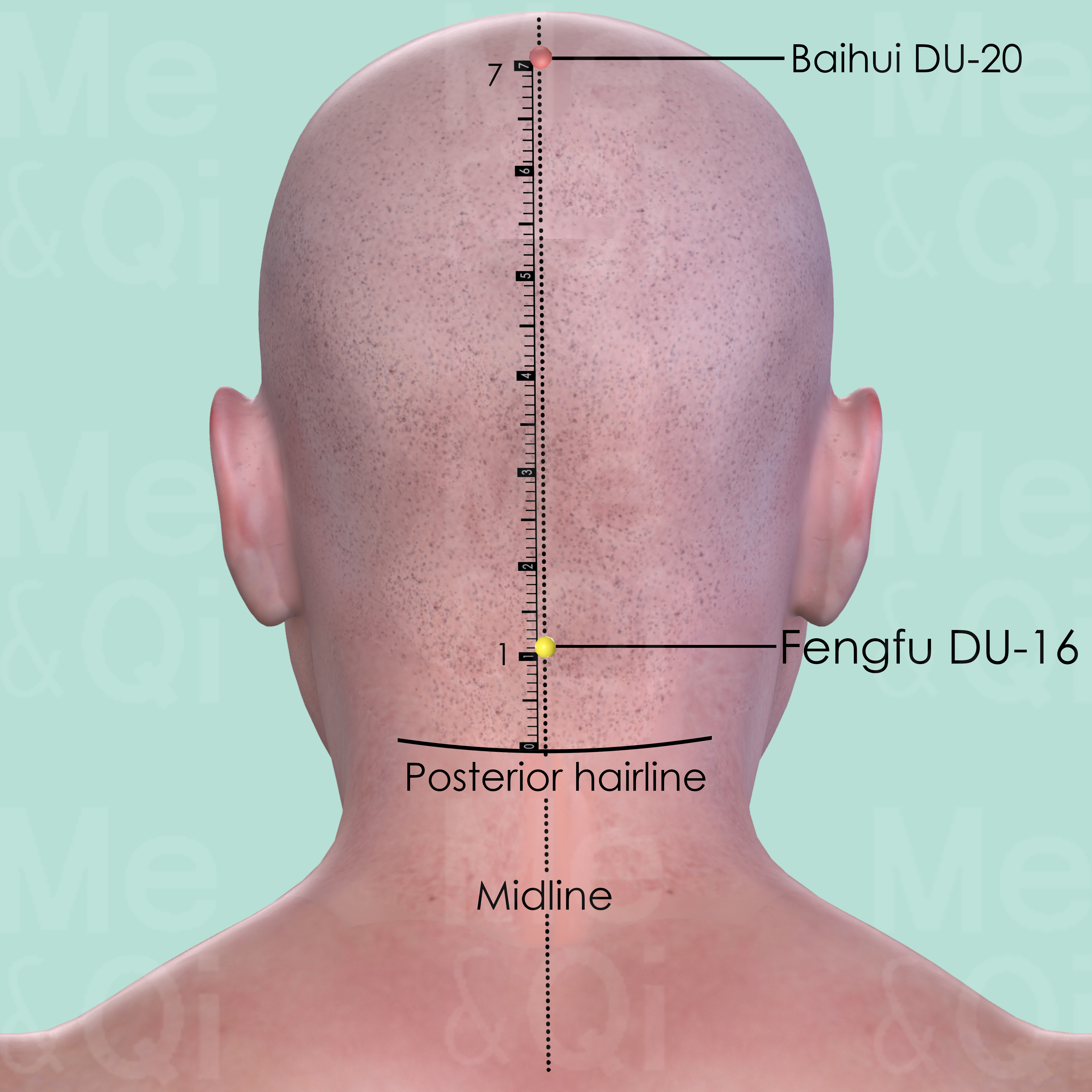
Fengfu DU-16
Directly below the external occipital protuberance, in the depression between the origins of the trapezius muscle.
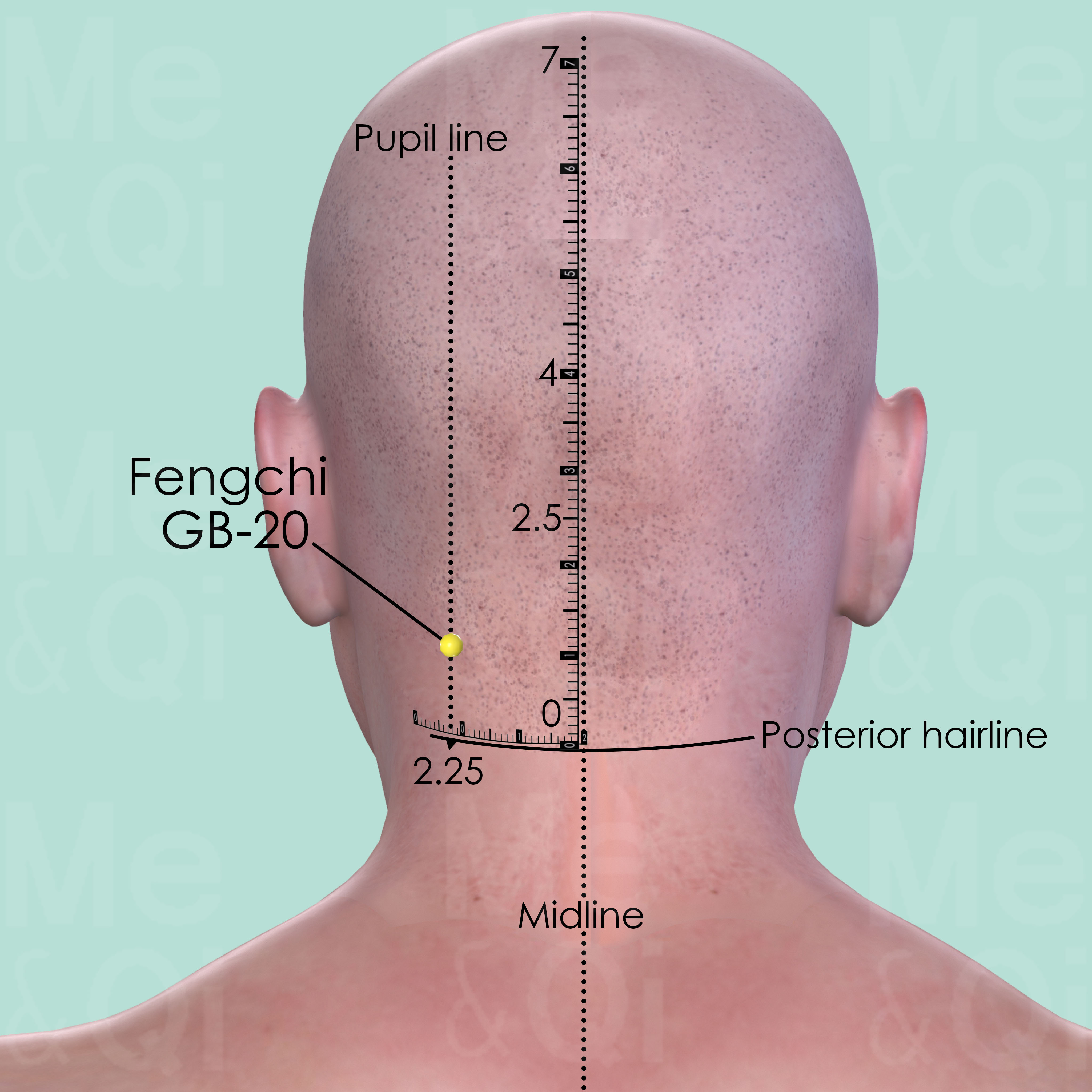
Fengchi GB-20
In the posterior aspect of the neck, below the occipital bone, in the depression between the upper portion of sternocleidomastoid and trapezius muscle.
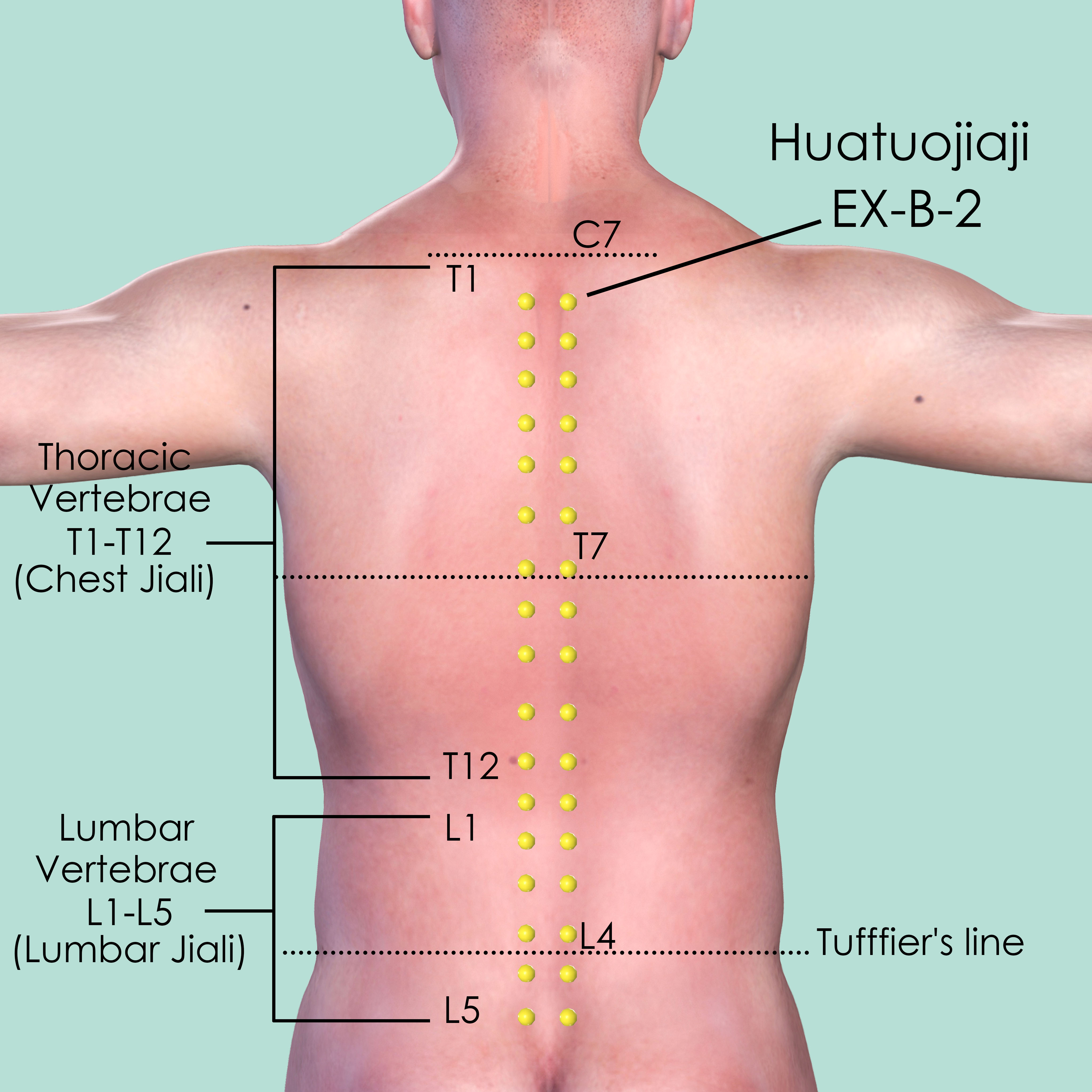
Huatuojiaji EX-B-2
This is a group of 17 point pairs. All of them are 0.5 cun lateral to the lower borders of the spinous processes of the 12 thoracic (Chest Jiali) and 5 lumbar vertebrae (Lumbar Jiali).

